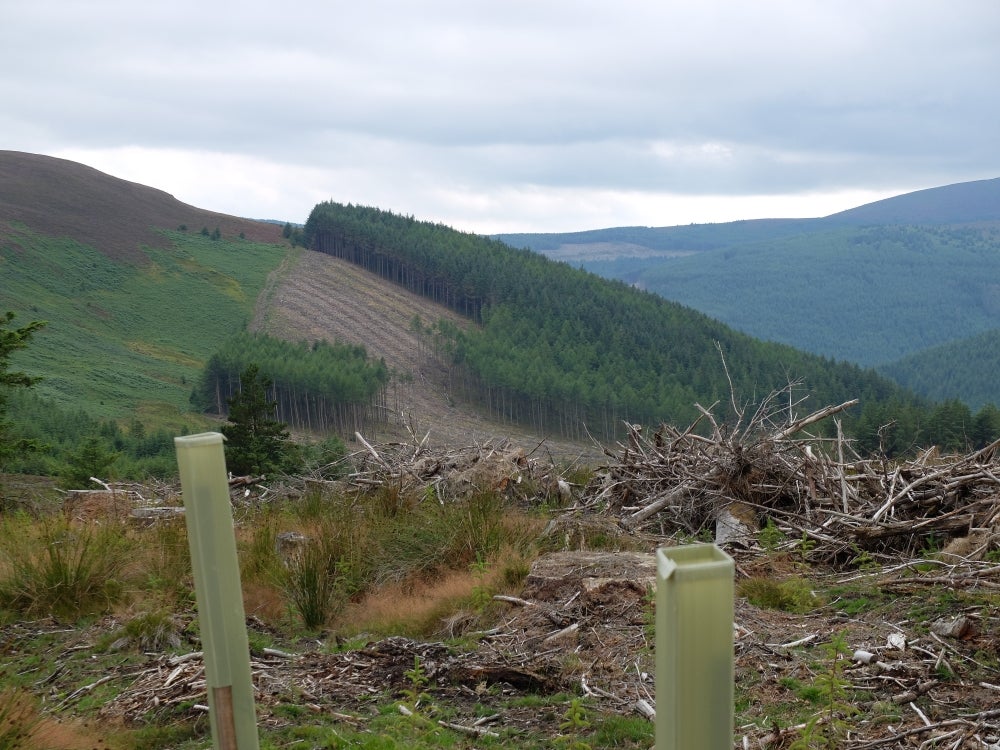
False Forests

Oak. Elm. Rowan. Ash. Willow. Hazel. Forests of these trees used to cover Ireland, and they are indelible in the Irish memory, yielding an ancient alphabet, giving their names to places and people, and ever-present in the old poems and songs.
What would the old poets say now, if they saw that the landscape was no longer home to groves of gnarled, spreading oaks of the Old World forests, but the towering, upright conifers of the American Pacific Northwest? Sitka spruce for example, constitute slightly more than half of Ireland’s tree cover.
“I remember when I was young, being confused by their presence,” said Ruby Harris-Gavin, a graduate student researcher in the lab of UC Santa Barbara ecologist Hillary Young. “I knew that they weren’t a normal forest.” She knew the conifers were there for some purpose, though, but the significance of their presence wouldn’t be clear until years later, during her undergraduate studies at UCSB, when she returned every year to Ireland to visit family and noticed the growing number of spruce stands.
“I think most people think, ‘oh, forests, you know. Those are good,’’’ she said. “But really what they’re creating are not forests.”
That assertion is the central thesis of Harris-Gavin’s essay, recently published in the interdisciplinary journal Éire-Ireland. For decades, conifer monocultures have proliferated on the landscape, planted and managed by the country’s Department of Agriculture, Food and the Marine (DAFM) and Coillte, Ireland’s leading forestry company, under the term “forest.”
It’s misleading, Harris-Gavin said.
“They’re using this positive association that people have with words like ‘forests,’ and ‘trees,’ and people aren’t looking into it beyond that.” What the foresters manage in terms of native trees “is very well managed,” she said, but native woodlands come to only slightly more than 1% of total tree cover. The majority of trees are fast-growing species, farmed and clear-cut.
A large part of the issue, according to her, is that the word “forest” has fluid connotations — rows of the same tree planted three feet apart can technically be called a forest, which for an ecologist like Harris-Gavin is a problem.
“People think the definition of a forest is one that has high levels of biodiversity and multiple types of trees, not just one type,” she said. “There’s understory and shrubs in a forest as well.” So while the word “forest” may conjure in the public’s imagination a collection of various native trees as well as shrubs, wildflowers and miscellaneous small plants, what they’re really getting are monocultured stands of trees that, according to her essay, “are planted and harvested as low-cost commercial produce.”
“A really crucial part of a forest is that it’s habitat for animals,” she said, “and we really don’t see that in Ireland.”
Ireland’s “conflicted national relationship with trees” is old and complex, Harris-Gavin notes in her essay, which also looks at the deep cultural and historical ties between the people and the trees. What began as dense forests in prehistoric times thinned out as the number of people grew and technology improved. The dependence on timber or cleared land increased, but so did the cultural awareness of trees and their value. Natural conversion into peatland also played a role in the reduction of the forests.
The most pronounced decline occurred during the time of English conquest and colonization of Ireland, though Harris-Gavin points out that colonization and commercial exploitation were not the only forces behind the decline: agriculture and development, industrialization, population growth, legislation and economy all served to take down the old forests.
Yet in the century leading up to independence, Irish revivalists would turn to woodland imagery to foster a growing sense of nationalism, calling forth scenes of a rural homeland for which to fight.
“Many of the poets and the people trying to start this Celtic revival were looking to the ancients and seeing that forests were really important for early Irish people,” she said. “It’s written in songs and poetry. People talk about the great heroes of the past and the mythology of Ireland speaks of expanses of huge oaks.” The oak became a prominent symbol of Irish patrimony even as the actual trees were being felled by tenant farmers to help purchase land from their former colonial landlords.
Sadly, according to Harris-Gavin, after the establishment of the Irish Free State in 1922, the status of the native tree as a venerated symbol of Irish culture wasn’t enough to withstand the economic burden of new independence.
“When the government first started in the 1920s, instead of capitalizing on this cultural inheritance of forests that people had been trying to start up, they turned trees into a commodity. And as a result, the people themselves had to do that, too,” she said. “And who could really blame them? They needed a new business for the country.”
Native forest cover by that time had dwindled down to 1% and perhaps worse, the memory of forests was also fading. Tree farms had already begun to spring up and fast-growing trees that can adapt to Ireland’s conditions were favored over slower-growing trees such as oak and ash. Enter the Sitka spruce — a tree that matures in decades and can grow in wet, waterlogged conditions.
Though conifer plantations have been economically successful, their continued proliferation, particularly as part of national “green” efforts, rings somewhat hollow with Harris-Gavin.
“They’re planting and clear-cutting,” she said. “Most of the research shows that old growth forest really helps because they’re carbon storage banks, whereas these trees are forced to live to about 30 years before the entire stand is cut down.” Though now illegal, conifer forests have been planted in peat bogs, which are major storage sites for carbon, she added, so tampering with the ground there would cancel out the carbon benefit of growing trees. Other ecological impacts include the loss of wildlife habitat and nutrient imbalances caused by tree monocultures, which can affect both soil and water.
Almost a century after the establishment of the Irish Free State, Harris-Gavin thinks the time is ripe for another Celtic Revival — this time not for independence, but for the land.
“Ireland really is an incredible country. Over the seven centuries of its colonization, Irish pride has raised its head time and time again,” she said. “Ireland has all of this cultural pride built into the country that is just waiting to be tapped.” Its bucolic rural setting outside of major cities like Dublin may yet hold enough sway for a movement to preserve and restore the nature it lost, according to her.
“I think Ireland could be an example for other countries that are developing,” Harris-Gavin said, “but want to preserve a lot of their landscape and move into a future that is sustainable and green.”



